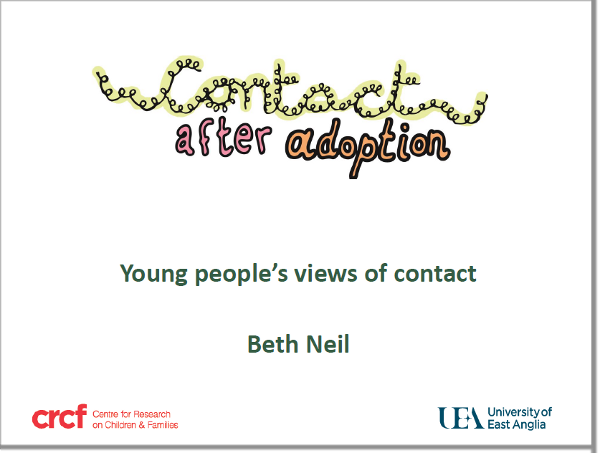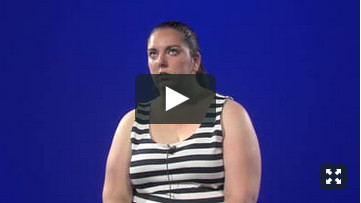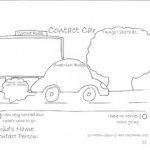Contents
Practice briefings
Messages from research on listening to children when planning and reviewing contact, taking into consideration the age and comprehension of the child.
- Practice brief: listening to very young children when planning and reviewing contact
- Practice brief: listening to young people when planning and reviewing contact
Exercises
This section contains a number of exercises that can be used to consolidate learning. They can be used for individual or team based learning, both for professionals and adopters. At the end of each sheet you will find some notes highlighting the main learning outcomes for each exercise.
- Exercise: listening to very young children in contact
- Exercise: understanding the significance of birth families
- Exercise: helping adoptive parents and social workers understand the benefits of contact
Practice resources
In this section you can find resources practitioners may find helpful as examples and can be adapted for use with families.
Worksheet for Children: the Contact Car by Mark Chesterman
Leaflet for adopted young people: research summary
Download the slides with notes Young people’s views of contact with birth relatives (1450kB) Powerpoint .PPTX file Slide presentation.
Film clips: young people discussing views on contact
Young people’s views and feelings: letterbox contact
Listen to three adopted children talk about their experience of letterbox contact, how they and their families have managed contact and what influence it has had on their life and identity.
Also viewable online via Adobe Connect
Young people’s views and feelings: openness with adoptive parents
Listen to four adopted children talk about their relationship with adoptive parents, what has been important to them and how their adoptive parents have supported contact (both letterbox and direct contact) and the adoption process.
Also viewable online via Adobe Connect
Young people’s views and feelings: direct contact
Listen to 2 adopted children talk about their experience of direct contact, how they and their families have managed contact and what influence it has had on their life and identity.
A full version of the film clip with young people’s views on contact after adoption can be found on the Case Studies and media clips page on the website.
Practice brief: listening to very young children when planning and reviewing contact
Context
- Children who are placed for adoption when they are very young may have no conscious memories of living with birth relatives or may never have done so
- Such children tend to find contact less emotionally demanding than older placed children who have troubled relationships and histories with birth families
- Contact may be less important for young placed children in the short term, but can provide help to establish relationships between everybody involved that can help to answer children’s questions as they get older, reducing the risk of unplanned contact
- When contact goes well for young placed children, it can become an ordinary part of everyday life rather than a big event
Listening and communicating with young children
- Young children may find it difficult to express their wishes about contact in words. They may have torn loyalties, mixed or changing feelings or echo the anxieties of their carers
- Using play and drawing can help some young children express their feelings about contact more easily
- Observing children’s response before, during and after contact is key to understanding their feelings. These observations need to be compared with how the child is day to day in their adoptive family
- Notice the child’s facial expression, how they hold their body, their gaze, whether they initiate or respond to play, the way that they speak as well as what they say, where they position themselves in the room, how they seek comfort, their response to food, any exchange of physical affection, or laughter
- Children may show anxiety in a number of ways: sleep disturbance, wetting themselves, vomiting, tantrums, regression, eating problems, being clingy or rejecting. Frightened children can appear anxious to please birth relatives, show fixed or frozen facial expressions, laugh without obvious amusement, cover their face or hide in a corner of the room. Some children respond with sexualised or aggressive behaviour. Babies may repeatedly avert their gaze, hold their body rigidly away from the adult or sleep excessively
- Sometimes children ask for more contact than they can manage
- Young children want to be asked about what they think about contact, but they need adults to make the decisions. They also need permission to choose not to express a view
- It is quite usual for young children to feel excited, anxious, worried about birth relatives, confused and sad around contact. They need the support and care of their adoptive parents to cope with these feelings. Ask yourself what the child’s earlier experience of these birth relatives might mean for contact, what pressures they might feel under and what could be done to make contact more enjoyable (Ashley, Lindley and Roth 2012)
Difficulties associated with contact
- Even very young children can respond fearfully to direct contact with adults who have abused or neglected them
- Contact can also bring back frightening memories of domestic violence for some young placed children
- Babies are highly attuned to adult facial expression and may be distressed by direct contact with adults who are unresponsive, intoxicated, frightened or frightening. They can also respond to negative interaction amongst adults during contact
- Children who do not have an established relationship with birth relatives may be shy and reluctant to interact with people they experience as ‘strangers’. It is important that children are allowed to feel comfortable at their own pace. Birth relatives may need help and suggestions about how to approach and engage the child
- Care is needed to differentiate a child who feels upset after contact because of the loss inherent in adoption and one whose recovery from harm may be damaged by continued contact
Supporting young children
- Talking about contact is an important opportunity to build closeness with adoptive parents
- Social workers can help by spending time talking and thinking with adoptive parents about the child’s experience and reviewing the plan for contact and support together
- Adoptive parents can help young children by accepting their connection with the birth family whilst affirming permanent membership of the adoptive family
Practice brief: listening to young people when planning and reviewing contact
Contact in adolescence can help to provide information, preserve or establish relationships and encourage openness within the adoptive family.
Young people’s views and needs for contact
- Older children may begin to think more about why they were adopted, what their birth family is doing now, whether they still care about them and where they came from
- As adopted children grow up their views about contact can change and adults should be aware of changing needs
- Some choose to take a break from contact while they focus on other things
- Others have new questions and want more or different contact
- Teenagers may feel ready for more information or changes to contact at different times – for some 16 is too early, for others it is too late
- Adopted young people generally want the door to future contact to be left open, even if they do not want contact right now
- Most older adopted children are happy with the contact that they have; they tend to value contact even when it is quite difficult
Managing expectations
- Young people may feel upset around contact or worried about birth relatives; they may not get the answers to their questions or experience a renewed sense of loss
- It can be hard when contact does not happen or letters are not sent
- The better a young person is doing generally, the better they are likely to cope with contact
- Unmet contact needs can drive undisclosed contact through social media; teenagers are safer on-line when adoptive parents accept their curiosity and search alongside them
Supporting teenagers
- Older children want adults to listen to them and take their views about contact seriously, but they still need adult support and guidance
- Adoptive parents can help by raising the subject of birth families, accepting their children’s thoughts and feelings and being willing to support them in trying out new kinds of contact
- Adoptive parents remain an important source of information; more information may need to be added to the life story book at this point
- Social workers can help by listening to young people, providing information and an opportunity to talk to someone outside the family and reviewing contact plans and the support provided
- Many adopted young people and their birth relatives worry about what will happen after they turn 18. A review could be offered as this milestone approaches. Support may still be needed in adulthood.
Exercise: Listening to very young children in contact
Download the exercise as a PDF (426KB)
Research messages
Contact plans need to be made and reviewed on an individual basis, taking into account this particular child’s experiences of contact with birth relatives in the situation. Understanding children’s feelings involves careful observation of their response before, during and after contact. Children are not always able to express their wishes verbally; non-verbal communication is very important.
Young children generally benefit from the presence of trusted adults during direct contact. When contact is difficult for children, professional support can help. This includes thinking about:
- when, where and how often the child has contact
- who supports them and the birth family
- what help birth parents might need in understanding and responding to the child
- how to ensure that everybody understands what is expected of them during visits.
All contact plans need to be provisional and regularly reviewed along with the support available.
This exercise is suitable for: individual learning; use during assessment and training of adoptive parents and in training for contact supervisors, social workers, foster carers, kinship carers and adopters.
Read the case study for Lacie and Carla. It relates to children who are at this time having direct contact with the birth parents. Consider the following questions:
- How do you think each child feels about contact with each parent? How do they communicate this? How would you convey this in a report for the court?
- What else do you need to know to make sense of what you see during this contact?
- What do you think their mother feels? Their father?
- How could the contact supervisor or social worker help to improve this contact for these children in the short term?
- How would each child’s non-verbal communication inform your thinking about future contact if these children are placed for adoption?
Trainer’s notes
Very young children may react to seeing parents after a separation in a number of ways, including greeting them with joy, clinging, responding angrily or ignoring them. Over time, this behaviour often settles as the child becomes familiar with the routine of contact and more able to enjoy time with a parent. Lacie and Carla have been having contact for many months, but continue to show distress. Lacie seems to be resisting contact by hiding her shoes and withdrawing emotionally during visits. The effort of managing her feelings seems to exhaust her. Carla’s behaviour is superficially more positive, but raises questions about whether she has learnt to please her father as a result of experiences of frightening behaviour from him or possible sexual abuse. It is important to observe these children before, during and after contact in order to make sense of their behaviour and to see them in other settings. Their current responses need to be put in the context of their experiences before removal.
It is also important to think about the overall level of contact, the venue, the time of day and the role of the supervisor in supporting the birth parents. It would be helpful to experiment with reducing the level of contact and working with the parents to improve their responses to the children before making a final decision about post- adoption contact, but the emotional impact of these visits on both girls suggests caution is needed about direct contact in the long term.
This case study can be compared with the one relating to the girls’ younger brother, Mikey, who has a different father and was removed at birth.
Exercise: understanding the significance of birth families
Download the exercise as a PDF (383KB)
Research messages
A minority of adopted young people simply accept the fact of their adoption and have no wish to find out more about their origins. Children’s views can change with time, but most adopted people have some curiosity about their birth family and want to understand why they were adopted. Some worry about their birth relatives or wonder if they have been forgotten. Birth parents usually live in the hearts and minds of their children even when they do not see or speak about them.
Children who grow up in adoptive families with high levels of adoption communication openness (that is an acceptance of difference and dual connection and of the child’s thoughts and feelings about the birth family) tend to develop the most positive sense of identity as an adopted person. Such families also tend to find it easier to manage contact, which in turn provides opportunities for thinking and talking about birth families. There is no evidence that post adoption contact, in itself, affects the overall outcomes of adopted young people.
This exercise is aimed at helping adoptive parents and social workers understand more about the abiding significance of birth relatives for most adopted children, whether or not they have direct contact.
Read the accompanying explanation to the song ‘History’ ‘History, the story behind the song’.
- How did the song make you feel?
- How might direct contact with her birth parents have helped this young woman as she was growing up?
- How might it have been difficult?
- What else, apart from direct contact, might be helpful to a young person in this situation?
Trainer’s notes
Those of us involved in making contact plans are rarely around to find out how these plans worked out in the long term and we are disproportionately likely to hear about it when our plans go wrong. This makes it particularly important for us to listen to what the research tells us about how contact affects the lives of adopted young people and to attend to the stories of adopted people as individuals. Of course, we cannot know how contact would have worked out for this person, but at least it would have provided an opportunity for her to learn more about her birth parents (for good and bad) and perhaps get some of the answers to her questions. She might have found out more about where her beautiful singing voice came from (along with the support and confidence to develop this talent that the adoptive parents perhaps provided). She might have felt disappointed in the reality of her parents, but at least she would have known more about who she was grieving.
Direct contact is not always safe or possible, but photographs, letters, information and life story work can make a contribution. Adoptive parents who meet birth parents are able to give their child a firsthand account of this. Some adoptive parents and children make safe use of social media to find out more about birth relatives without choosing to make contact.
Exercise: helping adoptive parents and social workers understand the benefits of contact
Download the exercise as a PDF (320KB)
Research messages
Post-adoption contact can be positive for many children, but plans need to be made on an individual basis, well supported and regularly reviewed. When adoptive parents are helped to understand that contact could help their child, they are more likely to support it.
This exercise is aimed at helping adoptive parents and social workers develop a positive attitude to post adoption contact and gain more understanding of how it can benefit adopted children.
Read the leaflet summarising the research findings (choose the leaflet for adoptive parents or the one for practitioners as appropriate). Then watch the video clips of young people talking about contact.
Consider the following questions:
- How do you think contact has benefited these young people? Their adoptive families?
- How has it been difficult?
- What help do you think they needed in coping with contact from their adoptive parents? From post-adoption support services?
- What messages do you think these young people might give to future adoptive parents about contact? To social workers who are making contact plans for children?
Trainer’s notes
The key message here is how all of these young people had unique experiences of contact and how their needs changed over time. The contact that they had has, to varying degrees, helped them to understand why they were adopted, provided information about birth families and reassurance that they were not forgotten and confirmation that their adoptive families accepted their sense of dual connection to two families. Being involved in decisions about contact allowed the young people to have some sense of control over their lives and avoided the need to seek unplanned contact on-line.
The adoptive families were able to grow closer to their children by supporting them with contact and learn more about their histories. Talking and thinking about birth families and being prepared to adapt arrangements as children got older will have been key to providing this support.
The young people might want adoptive parents and social workers to listen to them, to understand that contact matters and to think about how to make it work.
Worksheet for Children: the Contact Car
by Mark Chesterman
Leaflet for adopted young people: research summary

Download the leaflet as a PDF (2.5MB)
Contact after adoption: your views
A summary of key findings for adopted young people
This study started in 1996 and has been following up adoptive families and birth relatives since then. Some families have taken part three times, other families have taken part twice. This third stage of the study was carried out at the University of East Anglia by Elsbeth Neil, Mary Beek, and Emma Ward. It was funded by the Nuffield Foundation.







